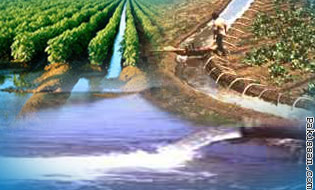|
Improving
irrigation technology
Affordable innovations, tailored to local conditions, are
readily adopted by resource-poor farmers...
Irrigated agriculture has driven much of the increase in
global food production over recent decades. While only 20% of
the world's farmland is irrigated, it produces 40% of our food
supply. The highest yields obtained from irrigation are more
than double the highest yields from rainfed agriculture - even
low-input irrigation is more productive than high-input
rainfed farming.

Why then is irrigated agriculture unlikely to expand as fast
it has over the past? One consideration is cost: irrigation
has been described as "one of the most subsidized activities
in the world", and some studies have cast doubts on the
economic returns on investment in large-scale irrigation
schemes. The environmental costs of conventional irrigation
are also high. High-intensity schemes are often blamed for
waterlogging and soil salinization, which now affect 30% of
irrigated land. Salinization is reducing the existing area
under irrigation by up to 2% a year. To increase irrigation's
contribution to food production, FAO says, what is needed is
improved efficiency in the use of irrigation water.
Drip, drip, drip... If incentives are in place, farmers will
adopt water-saving irrigation technologies. The main
technologies likely to be used in developing countries, where
labour is normally abundant but capital scarce, are
underground and drip irrigation. Both technologies depend on
the frequent application of small amounts of water as directly
as possible to the roots of crops. A major advantage of
water-saving technologies, particularly drip irrigation, is
that as well as saving water they can increase yields and
reduce the rate of salinization. Furthermore, since neither
system brings water into contact with foliage, they can be
used with brackish water for crops that are not too sensitive
to salinity.
Some underground irrigation systems do not require costly
equipment but are labour intensive. Indeed, one of the oldest
methods of irrigation is placing porous clay jars in the soil
around fruit trees and along crop rows. Porous or perforated
pipes buried underground serve the same purpose, and can
usually be used to irrigate two rows of crops, one on either
side of the pipe. The rate of application cannot be controlled
(although the frequency can) since it depends on the size of
the perforations and soil characteristics.
Drip irrigation - a pressurized system that forces water
through perforated pipes running above ground - has been
applied to only a small part of the area for which it is
suited. Though the technology is relatively simple, it does
require both investment and maintenance - water emitters can
easily become clogged. However, results from many countries
show that farmers who switched from sprinkler irrigation to
drip systems have cut their water use by 30-60%. Because
plants are effectively 'spoon-fed' the optimal amount of water
(and often fertilizer) when they need it, crop yields often
increase at the same time.
Drip systems generally cost in the range of $1,200-2,500 per
hectare, which is too expensive for most small-scale farmers
growing low-value crops. But with a few simple innovations,
costs can be cut dramatically. In Cape Verde, a drip
irrigation system introduced by an FAO project helped boost
the island's horticulural production from 5,700 tonnes in 1991
to 17,000 tonnes in 1999. More than 20% of the irrigated area
of the country has been converted to drip irrigation, and many
farmers had converted from water-consuming sugar cane
plantations to high-return peppers and tomatoes.
In South Asia, inexpensive treadle pumps have been successful
in extracting irrigation water from shallow aquifers, allowing
farmers to make good use of the household labour and increase
production and income. The farmer has full control over the
timing and amount of the pumped water which, given the effort
involved, is used sparingly. "Treadle pumps are intrinsically
pro-poor," FAO says, "as richer farmers would not be able to
persuade household members to use them." Positive experience
has also been reported with bucket drip-irrigation kits, which
are suitable for the irrigation of small plots of vegetables
and fruit trees in peri-urban areas. In Kenya, where farmers
have bought more than 10 000 kits, the return on an investment
of about US$15 per kit was some US$20 per month.
A range of other modern small-scale and supplementary
irrigation systems could help increase productivity in rainfed
areas. Pumping water with small-scale diesel or electric
engines is less labour-intensive than using a treadle pump,
and can be more economic than large-scale schemes that rely
heavily on centralized control. Furthermore, because
individual farmers are in full control of their own systems,
they can often maximize production to suit their own
lifestyles - something impossible with large,
centrally-controlled schemes.
Drainage problems. Drainage of irrigated land serves two
purposes: to reduce waterlogging and to control and reduce
salinization. Proper drainage also allows crop diversification
and intensification, the growth of high-yielding varieties,
and effective use of inputs such as fertilizers. Drainage
problems are serious on about 100-110 million hectares of
irrigated land located in the world's semi-arid and arid
zones. At present, about 20-30 million hectares of irrigated
land are seriously damaged by the build-up of salts and
0.25-0.5 million hectares are estimated to be lost from
production every year as a result of salt build-up. However,
even efficient drainage causes problems - drainage effluent is
often contaminated with salts, trace elements, sediments and
traces of agricultural inputs, which need to be safely
disposed of.
|
Pakissan.com;
|